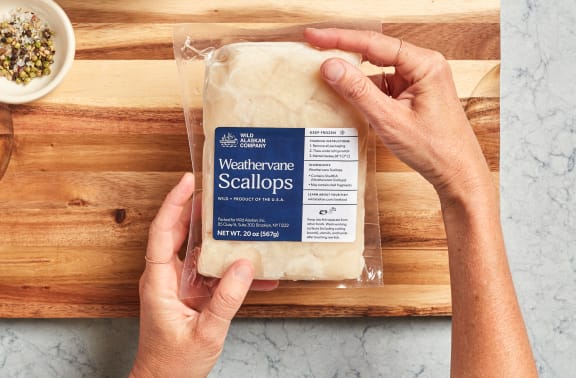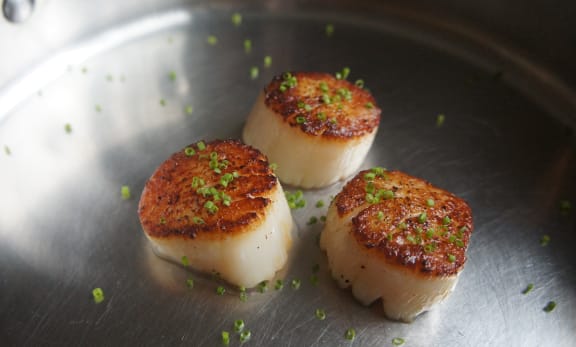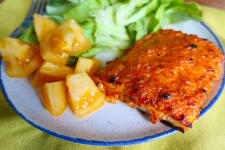Wet vs. Dry Scallops: Differences & How to Prepare Each
Wet scallops and dry scallops might look similar, especially to the untrained eye. But there are key differences between the two that affect everything from how they taste to how they sear. Knowing these differences will help you make the best appetizers and entrees you possibly can, no matter which type of scallop you’re cooking.
What Is the Difference Between Wet and Dry Scallops?
The terms “wet” and “dry” don’t describe a particular species of scallop, or how they're prepared for meals. Rather, whether the scallops are wet or dry actually describes how they have been preserved after harvest.
Wet and dry sea scallops have noticeable differences in size, texture, and taste. These differences can be traced directly back to how the scallops have been harvested and preserved.
At the grocery store counter, wet scallops can look glossier and plumper because artificial preservatives force them to carry more water weight than dry scallops. This excess moisture makes wet scallops nearly impossible to sear. The preservatives can leave behind a rubbery texture and off-flavors.
Dry scallops are harvested and preserved in a way that allows them to retain their natural moisture content and silky texture. Without any artificial additives, they’re succulent, sweet, and easy to sear.
How Are Wet Scallops Harvested?
Wet scallops are stored in cold sea water and treated with artificial preservatives that are designed to extend the shelf life of shellfish, usually a chemical called sodium triphosphate or STPP. These preservatives plump them up with water weight — which, by the way, you end up paying for at the grocery store. To find out if a product contains preservatives, make sure to read the packaging label closely.
How Are Dry Scallops Harvested?
Fishing vessels at sea catch, shuck, clean, and flash-freeze dry scallops within four short hours of harvest from fisheries. This process greatly preserves the quality of the scallops without having to rely on any artificial methods. That means they’re going to taste as good as freshly shucked.

Different Types of Scallops
There are a few different types of scallops that fishmongers typically offer.
Sea scallops
Sea scallops are harvested from the ocean floor by fishing vessels. Sea scallops are larger than bay scallops, ranging in size from “jumbo” (so large that you’ll get less than 10 scallops per pound) to petite enough that there are about 30 or 40 in every pound. There are many varieties of sea scallops, including WAC'S favorite: weathervane scallops.
Because of their size, sea scallops are ideal to use in recipes where they’re the featured protein, and they also have plenty of surface area for you to work with if you’re looking for a good sear. Good quality sea scallops are succulent and have a pleasantly chewy bite.
Bay scallops
Bay scallops are harvested in the shallower waters of the Atlantic ocean, typically near the mouth of a bay or estuary. They’re usually about ½ an inch in diameter, weighing in at up to 100 or so scallops per pound.
Compared to sea scallops, bay scallops are more tender and a bit sweeter. Because they are bite-sized, bay scallops work really nicely in stews or bakes.
Diver scallops
Diver scallops are sea scallops, but they’re harvested from the ocean floor by hand — by actual divers in scuba gear. Because the harvest process is so intensive, the availability of diver scallops is relatively limited.
Preparing Dry Scallops
When preparing dry scallops, it is crucial to pat the scallops dry by removing any excess liquid from the surface with a tea towel or paper towel; this step is especially important if you were thawing the scallops in cold water rather than defrosting them in the refrigerator. If you’re using a high-heat cooking method like searing, broiling, or grilling, moisture on the surface of the scallops will inhibit a golden crust from forming.

Seared scallops
Knowing how to sear scallops is an essential kitchen skill for seafood lovers. And it really just comes down to two things: A hot and heavy pan, and the right fat. With those two essentials, you’ll be able to turn out caramelized, crusty scallops without breaking a sweat.
A heavy pan, like a cast-iron skillet, is ideal for making pan-seared scallops. Non-stick pans won’t produce as good of a sear, but they are fine to use as long as they have a heavy bottom so that the scallops cook evenly.
You will need:
A heavy-bottomed skillet
A high-heat cooking fat (vegetable oil, canola oil, or ghee are good options)
Scallops
Sea salt and freshly-ground black pepper
Unsalted butter
-
Preheat your skillet over medium-high heat, adding just enough fat to coat the bottom of the pan.
-
Meanwhile, pat your scallops dry, removing any excess liquid from the surface with a tea towel or paper towel. Season scallops with salt and pepper.
-
Once your cooking fat has begun to shimmer, arrange your scallops in the skillet, leaving an inch or so of space around each to ensure that they can expel a bit of moisture without steaming one another. For best results, do this in batches rather than crowding the pan. Leave the scallops undisturbed as they cook, allowing the first side to sear until the scallops have developed a golden brown crust.
-
After about 2 to 3 minutes, peek at the seared side of one of the scallops to see if it’s had enough time to properly sear. If ready to flip, start turning your scallops with either a spatula or tongs, starting with the ones that you first put into the pan. Add a tablespoon or so of butter to the pan, then cook for another minute or so, basting the tops of the scallops with the butter as it melts. Smaller scallops may need less than a minute to cook through, while larger ones may need up to 2 minutes. Serve immediately.
Preparing Wet Scallops
When cooking with wet scallops, opt to use recipes and cooking methods where the texture of the scallops isn’t an integral aspect of the meal. Try baking them into a casserole, poaching them in a stew, or cooking them in a slow cooker within a flavorful sauce.
Baked scallops
Baking wet scallops in garlic, lemon, and white wine builds lots of flavor into an easy meal. This combination of flavors may also mask any off-flavors that might be contaminating the scallops. Baking the scallops under a layer of breadcrumbs helps to add an appetizing element of texture to the dish, even if the scallops you’re using are a little rubbery.
You will need:
Scallops
Extra virgin olive oil
Sea salt and freshly-ground black pepper
A baking dish
Melted butter
Minced garlic
Lemon
White wine
Panko breadcrumbs
-
Preheat oven to 425F.
-
Meanwhile, in a medium skillet, melt a couple tablespoons of butter over medium heat with a teaspoon or two of minced garlic until fragrant. Add about a cup of breadcrumbs (enough to generously cover the scallops) and toast until lightly golden.
-
Meanwhile, pat the scallops dry, then toss in enough extra virgin olive oil to lightly coat. Season with salt and pepper. Arrange in a single layer in a baking dish large enough to just fit the scallops. Squeeze lemon juice over the scallops, to taste.
-
Top scallops with garlicky breadcrumbs, then place on middle rack in oven. Cook until scallops have just cooked through, about 10 minutes.
Try Wild Alaskan’s Recipes for Weathervane Scallops
Wild, weathervane scallops from Alaska are some of the sweetest, butteriest scallops in the sea. That’s why weathervane scallop season is one of Wild Alaskan Company’s favorite seasons of the year (though we admit we genuinely love all types of wild-caught seafood, all year round).
We’re proud to offer sustainably harvested scallops to Wild Alaskan members seasonally, packed at the peak of freshness. Here’s a few of our favorite ways to enjoy them:
Enjoy Fresh Seafood Every Month
Becoming a member of Wild Alaskan Company gives you seasonal and sustainable access to wild-harvested weathervane scallops. Swim on over to our homepage to learn more about how our seafood subscription membership helps to support sustainable food systems while delivering nutritious, fresh seafood to fish lovers each month.






